|
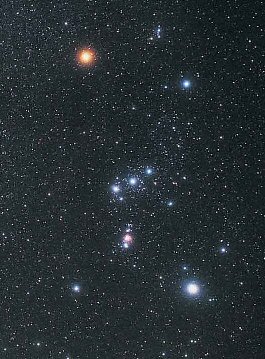
 Orion in Prehistory:
('As Above - So Below')
Orion in Prehistory:
('As Above - So Below')
The 'constellation'
of Orion the Hunter, is located along the celestial equator and is
therefore visible throughout the world. It is one of the most
conspicuous, and most recognizable constellations in the night sky
yet it has no place in the modern zodiac.
Both Sirius (the
brightest object in the sky after the sun and moon) and Betelgeuse
(Orion's shoulder) are two of the vortices of the Winter Triangle
(also known as the Great Southern Triangle), which show as an
equilateral triangle in the night sky.
Quick-Links:
|
Orion the Hunter:
(The Myth.) |
In Homer's
Iliad Orion is described as a hunter, and the star Sirius
is mentioned as his dog.
In
Greek Mythology Orion was the
son of Poseidon and Euryale. Like
most of Poseidon's children, Orion
was a man of gigantic proportions.
He also was quite the hunter, and
the constellation that bears his
name forms the shape of a great
hunter in a defensive pose against
Taurus, the bull.
While
a young man Orion fell in love with
Merope, the daughter of Dionysus and
Ariadne.) Orion sought to marry
Merope and he remained in the king's
service for some time attempting to
win his favor, but Oenopion dragged
his feet in arranging the marriage.
Impatient, Orion raped Merope.
Naturally, the king decided to take
revenge. He got Orion drunk, and
when the giant fell asleep, Oenopion
put his eyes out and threw him out
towards the sea.
Orion
wandered around blind until he
bumped into Hephaestus, who, taking
pity on him, gave him a boy to help
guide him. With the boy on his
shoulders as his guide Orion made
his way to the east, where the
rising sun restored his sight. Once
again a while man and extremely
angry, Orion set out to kill
Oenopion. Fortunately for the king
Hephaestus had foreseen this and
built Oenopion an underground
chamber to keep him safe. Unable to
find the king of Chios, Orion gave
up, and instead went with Eos, who
had fallen in love with him. She
took him to Delos, where he served
her sexually.
In the sky, Orion is depicted
facing the snorting charge of neighbouring Taurus the Bull, yet
the myth of Orion makes no reference to such a combat. However,
the constellation can be traced back to the Sumerians, who saw
in it their great hero Gilgamesh fighting the Bull of Heaven.
The Sumerian name for Orion was
URU AN-NA,
meaning light of heaven. Taurus was
GUD AN-NA,
bull of heaven. Gilgamesh was the Sumerian equivalent of
Heracles. One of the labours of Heracles was to catch the Cretan
bull, which would fit the Orion�Taurus conflict in the sky.
Ptolemy described him with club and lion�s pelt, both familiar
attributes of Heracles, and he is shown this way on old star
maps.

Orion raises
his club and shield against the charging Taurus in this
illustration from the Uranographia of Johann Bode (1801).
Orion�s right shoulder is marked by the bright star
Betelgeuse, and his left foot by Rigel. A line of three
stars forms his belt.
Stories of the death of Orion are
numerous and conflicting. Astronomical mythographers such as Aratus,
Eratosthenes and Hyginus were agreed that a scorpion was involved.
In one version, told by Eratosthenes and Hyginus, Orion boasted that
he was the greatest of hunters. He declared to Artemis, the goddess
of hunting, and Leto, her mother, that he could kill any beast on
Earth. The Earth shuddered indignantly and from a crack in the
ground emerged a scorpion which stung the presumptuous giant to
death. The outcome was that Orion and the scorpion (the
constellation Scorpius) were placed on opposite sides of the sky, so
that as Scorpius rises in the east, Orion flees below the western
horizon. �Wretched Orion still fears being wounded by the poisonous
sting of the scorpion�, noted Germanicus Caesar.
(More
about Prehistoric Greece)
Chinese
Astronomers knew Orion as Shen, a great hunter or
warrior, one of the rare cases in which a constellation was
visualised almost exactly the same way in China as in Europe.
Shen was at the centre of a great celestial hunting scene, for
the full moon is in this part of the sky during the hunting season,
November and December.
the main body of
Shen consisted of 10 stars: The four that make up the
traditional outline of Orion (Alpha, Gamma, Beta and Kappa), the
three stars of the belt and the three stars of the 'sword'. The
sword stars had a dual identity, as they also formed a
sub-constellation, Fa. In keeping with Shen's identity
as a warrior chief, the 10 stars were also imagined as his various
army generals.
The triangle of
stars that form Orion's head (Lambda, Phi-1 and Phi-2) was known as
Zui, the beak of the turtle or a bird - possibly a falcon
used for hunting. Zui was also the name of the 20th Lunar
mansion, but it was the narrowest of all the mansions (barely 2�
wide) because it was so close to the 21st mansion, named Shen.
The arc of stars that we see today as Orion's shield was interpreted
in China as a banner, Shenqi, or sometimes a longbow.
Being one of the
oldest Chinese constellations, Shen gathered many different
and conflicting identities down the ages. Early on, it was seen as
the forequarters of the 'White Tiger', one of the four seasonal
divisions of the Chinese sky.
(More
about Prehistoric China)
The Ancient
Egyptians
were the first to write about Orion, and place him into their
mythologies. They associate the stars of Orion with Osiris, the
sun-god of rebirth and afterlife, and one of the most important gods
of the ancient Egyptians. (1)
Orion was considered the abode of Osiris following his resurrection.
Isis dwelt on Sirius. In Egyptian mythology, Osiris was murdered and
dismembered by his jealous brother, Seth, then briefly brought back
to life by his sister and consort Isis to father the god Horus.
Egyptians saw Osiris in the Moon, whose phases caused the
all-important Nile to rise and fall each month, and in the
constellation Orion, whose appearance was connected with the annual
flood. As god of the dead, Osiris welcomed the recently deceased to
their new world.
Sirius, the
brightest star in the sky, rises on the eastern horizon just before
the Sun once each year. This following a period of complete
invisibility lasting about 70 days (during which time it lies in the
daytime sky). Egyptian inscriptions describe the last appearance of
Sirius in the night sky as its death; its daytime invisibility as
purification in the embalming house of the nether world; and its
rising with the Sun as a resurrection. Accordingly they calibrated
the process of mummification to this celestial cycle, completing it
in exactly 70 days.
(Ancient
Egypt Homepage)
|
The Giza Pyramids as a Representation of Orion's Belt: |
The Orion theory by Robert Bauval
was first published in 1989 in the journal
Discussions in Egyptology, vol. 13. He proposed that the Giza
pyramids were a physical representation of the three stars that make
up Orion's belt. Although aspects of the original theory were heavily refuted, the main tenet of the
theory still holds true.
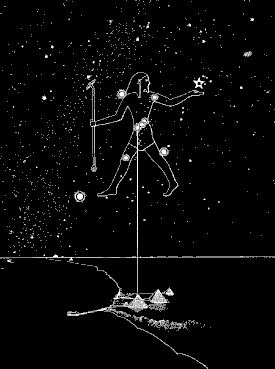
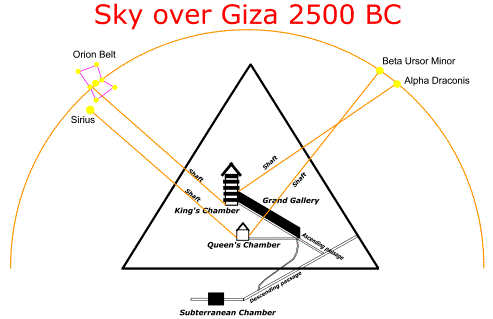
In addition to
the ground-plan of the pyramids themselves being identified with
Orion, the 'Star chambers' have also been shown to have a
correlation with Orion, Sirius and the Pole stars of the day.
(Egyptian
Astronomy)
Criticisms
of the Orion Theory:
The theory
has been contentious since its outset. Ed Krupp (Griffith
Observatory in Los Angeles) and Anthony Fairall (astronomy
professor at the University of Cape Town) have both
criticised the astronomical observations which underpin the
theory and even suggested that in order to make the facts
fit the map of the pyramids had to be inverted. However,
Archie Roy (Professor Emeritus of Astronomy at Glasgow
University) and Percy Seymour (astronomer and astrophysicist
at Plymouth University) have defended the theory and noted
that the visual correlation is striking when the pyramids of
Giza are viewed from the north. Furthermore, there is some
support for it in the fact that the Pyramid Texts (which
date to the fifth dynasty but were most likely formed from
earlier religious concepts) make frequent references to the
connection between the the resurrection of the king and Sahu
(The earliest Egyptian representation of Orion).
(More on the
Dating of the Great Pyramid)
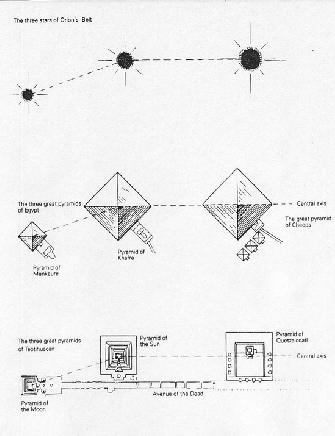
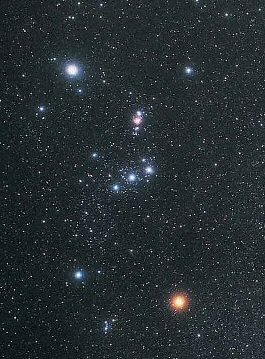
The same layout
has been claimed for Teotihuac�n, in Mexico (Above, bottom-left)
The 'Pyramid of the
Sun' at Teotihuac�n has the same base dimensions as the
Great
pyramid of Giza, but is is exactly half the height. It
appears as if both cultures incorporated Pi into their dimensions:
(Archaeoastronomy Homepage)
|
Triple
Circles/Henges in the UK: |
England is home to examples of numerous
double circles, as well as several 'Triple-circles' such as 'The
Hurlers',
Merrivale,
Stanton Drew,,
Avebury,
Thornborough and
Grey Wethers,
to name but a few. Their exact purpose is still only to be guessed at, but a
geometric and/or astronomic association is predicted.
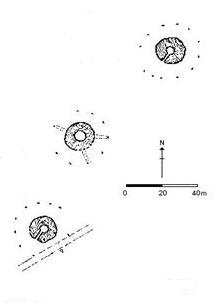
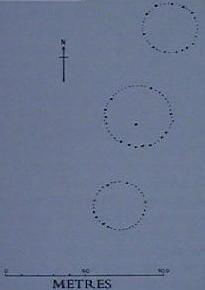
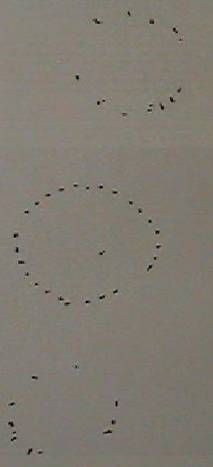

(From left to right:
Clava cairns,
The Pipers,
The Hurlers
and
Avebury)
(Note: Although it is not
commonly mentioned, a fourth circle has been shown to have
once existed at Avebury. It was discovered in 1937 by 'A.
Keiller', who found three 'unrecorded stone holes...eleven
metres apart on the arc of a circle about 103m in diameter,
much the same as the 'North' and 'South' inner circles,
whose stones were also placed about eleven metres apart).
An example of a
'Triple RSC' can be found at Loanhead of Daviot, in Scotland, where three Neolithic
recumbent circles were once aligned. The circle in Daviot
churchyard was removed in 1820, and all that remains of New
Craig is the recumbent, its flankers and a few odd stones now
built into a field wall. (4)
The theme of triple-aligned circles is also
common to
Henges, such as the Priddy circles, and
Thornborough.

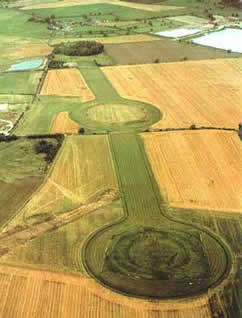
The three
Devil's Arrow's
(left), are aligned towards the
Thornborough Henges (right).
The largest triple
Henge in Britain is at the Thornborough complex (Above, right). It
also shows a slight 'dog-leg', and work by Prof. Clive Ruggles
(3),
who postulated that there were demonstrable alignments between the
Henges and the astronomical features of Orion was later
supported by the research of the eminent archaeologist, Dr. Harding,
senior lecturer at Newcastle University. He demonstrated the
similarity of the placing of the three great Henges on the landscape
and the three stars of Orion�s Belt. In addition, archaeological
work at Thornborough suggested that Orion was significant prior
to the construction of the three Henges.
The first major
monument on the site was built around 3,500BC. This was a 1.2km long
Cursus, aligned so its western end pointed towards the
mid-winter setting of Orion. This also meant the eastern end aligned
to the midsummer solstice. At around 3000 BC, when the three
Henges at Thornborough were constructed, they appear to have been
deliberately laid out to mirror Orion�s Belt. Not only this, but
their southern entrances framed the rising of the bright star,
Sirius, which in turn meant their axis aligned on the midwinter
solstice.
(More
about The Thornborough Complex)

A similar layout has
been shown to exist at the Hurlers stone circle, which was
orientated towards Orion on the summer solstice. The Hurlers have
been dated at c. 1,500 BC, while the Henges at Thornborough are
dated at around 3,500 BC, suggesting a continuous form of Orion
worship existed in the UK for around 2,000 years. A recent dig has
uncovered a 'crystal (quartz) avenue running between the
circles. (5)
(More
about the Hurler's)
(Archaeoastronomy)
(The
Giza Pyramids) (The
'Khufu Calendar')
|










